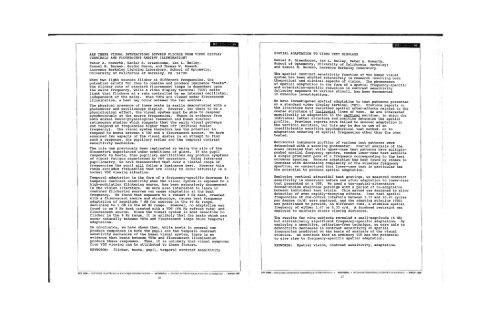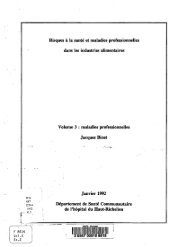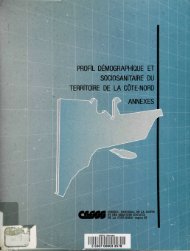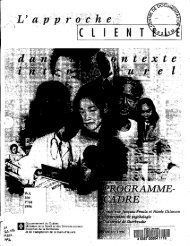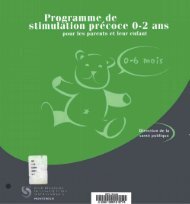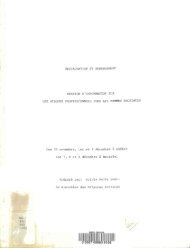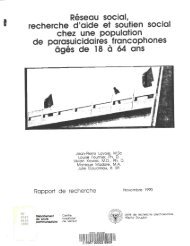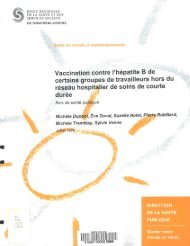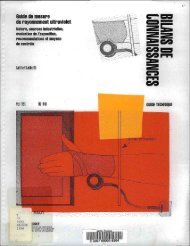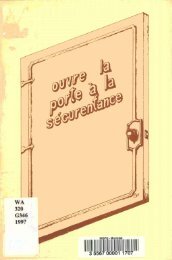le travail à l'écran de visualisation work with display units
le travail à l'écran de visualisation work with display units
le travail à l'écran de visualisation work with display units
Create successful ePaper yourself
Turn your PDF publications into a flip-book with our unique Google optimized e-Paper software.
ARE THERE VISUAL INTERACTIONS BETWEEN FLICKER FROM VIDEO DISPLAYTERMINALS AND FLOURESCENT AMBIENT ILLUMINATION?Peter A. Howarth, Daniel S. Greenhouse, Ian L. Bai<strong>le</strong>y,Samuel M. Berroan, Gordon Heron, and Thomas W. Raasch.Lawrence Berke<strong>le</strong>y Lighting Laborabory, School of Optometry,University of California at Berke<strong>le</strong>y, CA 94 720When two light sources flicker at different frequencies, thepotential exists for them to combine and produce luminance "beats".The flicker rate of standard fluorescent lamps is <strong>de</strong>pen<strong>de</strong>nt uponthe mains frequency, whi<strong>le</strong> a vi<strong>de</strong>o <strong>display</strong> terminal (VDT) emitslight that flickers at a rate control<strong>le</strong>d by an internal oscillator,in<strong>de</strong>pen<strong>de</strong>nt of the mains. When VDTs are viewed un<strong>de</strong>r flourescentillumination, a beat may occur between the two sources.The physical presence of these beats is easily <strong>de</strong>monstrated <strong>with</strong> aphotometer and oscilloscope <strong>display</strong>. However, for there to be aphysiological effect, the visual system must be ab<strong>le</strong> to respondsynchronously at the source frequencies. There is evi<strong>de</strong>nce fromboth animal neuro-physiological research and human e<strong>le</strong>ctroretinogramstudies which suggests that the early visual pathwayscan respond at frequencies higher than CFF (critical fusionfrequency). The visual system therefore has the potential torespond to beats between a VDT and a flourescent source. We haveexamined two aspects of the visual system in an attempt to findsuch a response, the pupillary ref<strong>le</strong>x and the temporal contrastsensitivity mechanism.The iris has previously been implicated as being the site of thediscomfort experienced un<strong>de</strong>r conditions of glare. If the pupilresponds to beats, then pupillary oscillations may produce symptomsof visual fatigue experienced by VDT operators. Using infra-redpupillometry, we have <strong>de</strong>monstrated that over a limited range offrequencies the pupil will follow a luminance beat. However thisrange exclu<strong>de</strong>s frequencies that are likely to occur naturally in anormal VDT viewing situation.Temporal adaptation in the form of a frequency-specific <strong>de</strong>crease intemporal contrast senstivity when the visual system is exposed to ahigh-modulation flickering source, has been extensively documentedin the vision literature. We were also interested to <strong>le</strong>arn ifcombined flickering sources can cause adaptation at the beatfrequency. We found that exposure to a robust 8 Hz beat, created<strong>with</strong> a fluorescent source and stroboscope, causes beat frequencyadaptation of magnitu<strong>de</strong> 7 dB for sources in the 40 Hz range,<strong>de</strong>clining to 1 dB in the 60 Hz range. However, no adaptation wasfound to an 8 Hz beat created <strong>with</strong> a VDT (60 Hz refresh rate) andfluorescent source. Since the visual system is most sensitive toflicker in the 8 Hz range, it is unlikely that the beats which canoccur naturally between VDTs and fluorescent lamps cause temporaladaptation.In conclusion, we have shown that, whi<strong>le</strong> beats in general canproduce responses in both the pupil and the temporal contrastsenstivity mechanism of the human visual system, there is noevi<strong>de</strong>nce that beats between VDTs and fluorescent illuminationproduce these responses. Thus, it is unlikely that visual symptomsfrom VDT viewing can be attributed to these factors.KEYWORDS:flicker, beats, pupil, temporal contrast sensitivitySPATIAL ADAPTATION TO VIDEO TEXT DISPLAYSDaniel S. Greenhouse, Ian L. Bai<strong>le</strong>y, Peter A. Howarth,School of Optometry, University of California, Berke<strong>le</strong>y;and Samuel M. Berman, Lawrence Berke<strong>le</strong>y Laboratory.The spatial contrast sensitivity function of the human visualsystem has been studied extensively in research involving boththeoretical and clinical aspects of vision. The phenomenonof spatial adaptation in the form of a spatial frequency-specificand orientation-specific reduction in contrast sensitivityfollowing exposure to various stimuli, has been documentedin numerous investigations.We have investigated spatial adaptation to text patterns presentedon a standard vi<strong>de</strong>o <strong>display</strong> terminal (VDT). Previous reports inthe literature have <strong>de</strong>scribed spatial after-effects related to thecoarse structure of horizontal lines of text. We are interestedspecifically in adaptation in the vertical meridian, in which theindividual <strong>le</strong>tter structure and position <strong>de</strong>termine the spatialprofi<strong>le</strong>. Previous reports have fai<strong>le</strong>d to uncover adaptation inthe vertical meridian, but this may be due to use of aninsufficiently sensitive psychophysical test method, or toadaptation occuring at spatial frequencies other than the onestested.Horizontal luminance profi<strong>le</strong>s of various text patterns were<strong>de</strong>termined <strong>with</strong> a scanning photometer. Fourier analysis of thescans revea<strong>le</strong>d that whi<strong>le</strong> upper-case text patterns have multip<strong>le</strong>peakedspatial frequency spectra, random lower-case text exhibitsa sing<strong>le</strong> prominent peak at a frequency corresponding to the textcolumnar spacing. Because adaptation has been found by others toincrease <strong>with</strong> <strong>de</strong>creasing comp<strong>le</strong>xity of the stimulus frequencyspectrum, we conjectured that lower-case text in particular hasthe potential to produce spatial adaptation.Employing vertical sinusoidal test gratings, we measured contrastsensitivity in observers before and after adaptation to lower-casetext presented on a VDT. We used a two-spatial-alternativeforced-choice staircase paradigm <strong>with</strong> a period of re-adaptationbetween individual test trials. This method was <strong>de</strong>signed to allow<strong>de</strong>tection of even rapidly-<strong>de</strong>caying effects. Four test spatialfrequencies at one-octave intervals between 1.33 and 10.67 cyc<strong>le</strong>sper <strong>de</strong>gree (c/d) were employed, and the adapting stimulus (VDT)was positioned to provi<strong>de</strong>, on different runs, a stimulus spatialfrequency of either 2.67 or 5.33 c/d. A forehead restraint wasemployed to maintain stab<strong>le</strong> viewing distances.The results for nine subjects revea<strong>le</strong>d a small-magnitu<strong>de</strong> (6 dB)but statistically significant frequency-specific adaptation. Byemploying a sensitive, criterion-free technique, we were ab<strong>le</strong> to<strong>de</strong>monstrate <strong>de</strong>creases in contrast sensitivity at spatialfrequencies predicted on the basis of analysis of the visualstimulus. We conclu<strong>de</strong> that an ordinary VDT has the potentialto give rise to frequency-specific spatial adaptation.KEYWORDS:Spatial vision, contrast sensitivity, adaptation.TEV 1989 — DEUXIÈME CONFÉRENCE SCIENTIFIQUE INTERNATIONALE • MONTRÉAL • SECOND INTERNATIONAL SCIENTIFIC CONFERENCE — WWDU 1989TEV 1989 — DEUXIÈME CONFÉRENCE SCIENTIFIQUE INTERNATIONALE • MONTRÉAL • SECOND INTERNATIONAL SCIENTIFIC CONFERENCE — WWDU 198912566


